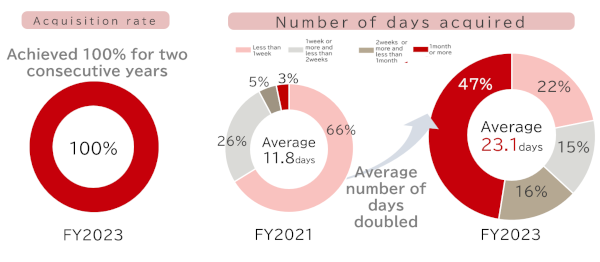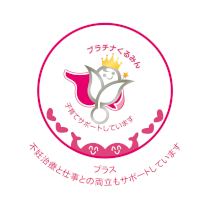Diversity, Equity & Inclusion
Dai-ichi Life strives to promote work-life management of our employees based on two pillars - the Improvement of work-life support systems and the promotion of flexible work styles and creating an environment in which our employees can work with enthusiasm. Further, from fiscal year 2022, for the promotion of having our male employees taking on a more active role in childcare with their partners, Dai-ichi Life has set a company goal of 100% of our employees who will become expecting fathers take paternity leave for a minimum 1 month cumulatively. In addition, we hold seminars to promote awareness and provide educational materials on taking childcare leave and provide communication tools for managers and team members.
Promotion of flexible workstyles
|
Reduction of total working hours
A target time of for the end of the working day (bottom line target) Planning a “Work Smart Day” once a week month (no-overtime day) Planning a “Blue Sky Day” at least once a month (starting the workday at 10am or finishing at 3pm) Automatic PC shutdown by 8:00 pm A minimum 11-hour interval between workdays
|
|
Promotion of various types of leaves
Target of acquiring 70% of annual paid leaves Taking at least one paid leave day per month on average (ensuring the acquisition of 5 annual paid leave days) Our company encourages employees to take at least one day of paid leave per month (excluding summer and New Year's holidays). QOL improvement leave (leave intended to improve QOL / health, such as to nurse family members, attend school events for children in junior high school and above, go to hospitals for fertility treatment, go to hospitals for menopause treatment, participate in volunteer activities, take health checkups) Hourly paid leaves Establish work-life management (WLM) indicators, thereby visualizing each organization's working hours, usage rate of paid leave, and usage rate of telework
|
|
Promotion of diverse working styles
Utilization of teleworking Utilization of flextime and staggered working hours Introduction of casual dress code Approval of side-jobs outside of the company My Career Preparation Leave (As a measure to enable flexible career development, employees can take unpaid leave for up to three years. Employees can acquire deeper skills and career development by entering full-time graduate school, etc. Also applicable to truly unavoidable family circumstances such as devoting oneself to infertility treatment over the medium to long term)
|
Enhancing support systems for balancing childcare and work
* The following primarily describes systems and initiatives that exceed legal requirements or are unique to our company.
|
Support from pregnancy to birth
Prenatal and postnatal leave (100% paid leave for 6 weeks before and 8 weeks after childbirth) Maternity leave (up to 5 days per month can be used as paid time for pregnancy-related ailments such as morning sickness and hospital visits) Leave when spouse gives birth (3 paid days granted when spouse gives birth) Grandchild birth leave (3 paid days granted upon the birth of a grandchild)
|
|
Childcare support
Childcare leave (until the end of April or end of October, whichever comes first a month after the child turns 1 year and 6 months old; depending on the situation, this can be extended until the child turns 2 years old) Childcare Time (Up to two 30-minute breaks per day for employees with children under the age of one) Child support / Childcare leave (Up to 12 days (paid leave) per fiscal year for nursing care of children's illnesses and other issues, regular vaccinations, health checkups, temporary closure of children's schools, and participation in school events until the child finishes their sixth year of elementary school) QOL improvement leave (Paid days off that can be used for nursing care of children's illnesses, participation in school events, and similar reasons for children in junior high school and above) Special Paid Leave for Child's Infectious Illness (up to five days of paid special leave per fiscal year when caring for a child (up to the end of elementary school) who has contracted an infectious disease as defined by the School Health and Safety Act, or when the child's class is temporarily closed under the same Act.) Reduction of working hours and exemption from overtime until a child graduates elementary school Subsidy for childcare support service expenses Access to childcare-related services through “Benefit Station” (Employees can use a variety of childcare-related services at discounted rates-such as baby products (including nursing wear and breastfeeding equipment), babysitting, housework support, and assistance with nursery school applications. In addition, points that can be used for various services are granted annually) [Starting October 2025] Early Comeback Support Plan (Female employees who return to full-time work (including exemption from overtime) from maternity or childcare leave before their child reaches 14 months of age will receive points equivalent to ¥50,000 per month. These points can be used for childcare-related services through the Benefit Station cafeteria plan until the child turns two years old)
|
|
Support for men participating in childcare
Promoting the goal of 100% of male employees to take childcare leave for a total of 1 month or more Up to 20 days paid leave are granted for each child when taking childcare leave “Fatherhood Training Program” held for male employees and their partners Shared stories of male employee's experiences of childcare leave on the company intranet
|
The promotion of male employees taking childcare leave
From fiscal year 2022, we have been working towards the goal of having 100% of our male employees take a cumulative total of at least one month of childcare leave. We are implementing initiatives that go beyond legal requirements, such as raising awareness through “Fatherhood Training Program” so that our male employees can proactively engage in childcare and housework, submitting written childcare leave plans, and granting up to 20 days of paid leave. We also hold “Ikuboss seminars” for management-level employees, share experiences of male employees who have taken paternity leave on our Intranet, and work towards creating a workplace environment where diverse employees can support each other through understanding and collaboration.

- * 5 Total for Dai-ichi Life Holdings, Dai-ichi Life, Dai-ichi Frontier Life and Neo-First Life
Support for Balancing Various Life Events and Work
|
Nursing care support
Nursing care leave (a total of 730 days can be taken from the start date of each person requiring care) Nursing care support leave (up to 12 days (paid leave) per fiscal year can be taken to accompany hospital visits or care for to a person in need of care) Reduced work hours and exemption of overtime for nursing care QOL improvement leave (For nursing care of family and relatives) Distribution of the Work and Nursing Care Balance Handbook Holding seminars and roundtable discussions on nursing care
|
|
Medical treatment support
|
|
Other support measures
Holding an “Ikuboss Seminar” for management-level employees F Leave (two days a month leave for menstruation-related ailments) Family Transfer System (Transfer system due to family reasons for employees in a job category with limited working areas) Leave to accompany spouse secondment abroad (Up to three years unpaid leave when accompanying a spouse's international secondment) Distribution of the Work-Life Support System Handbook Work-Life Balance Support Hotline Access to childcare, nursing care, health, and medical treatment services through “Benefit Station” (Employees have access to a range of services related to childcare, nursing care, health, and medical treatment through “Benefit Station.” In addition, points that can be used for these services are granted annually) [Starting October 2025] Maternity, childcare, and nursing care support subsidy (One-off payments will be provided to employees whose work is affected by coworkers taking three or more consecutive months of leave for maternity, childcare, or nursing care)
|



